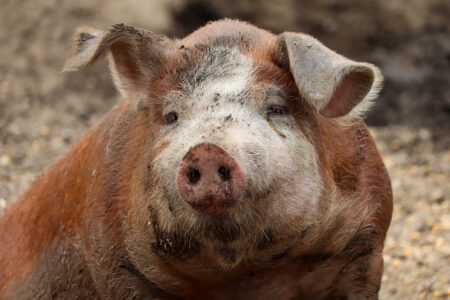Where did the Hereford pig originate? Read more about the Hereford pig breed, an easygoing hog that adapts nicely to most climates.
Homegrown Pork (Storey Publishing, 2013) by Sue Weaver guides you through the process of choosing a flavorful pig breed and instructs you on formulating a proper diet and providing safe and comfortable living quarters for your backyard animal. The following breed profile for the Hereford hog is from chapter 4, “Breeds.”
You can purchase this book from the MOTHER EARTH NEWS store: Homegrown Pork
Hereford Hog
Type: Modern meat
Origin: Iowa and Nebraska, United States
Color: Red with white face, belly, legs, and tail markings (exactly like those of Hereford cattle)
Size: Large
Conservation Status: Watch
Description: The Hereford is a flashily colored pig with a long neck; wide, dished face; medium-size, drooping ears; and a curly tail.

R. U. Webber of La Plata, Missouri, developed the first Hereford pigs by crossing Durocs, Chester Whites, and Ohio Improved Chester genetics; however, the Webber bloodlines died out. Later, between 1920 and 1925, a group of breeders in Iowa and Nebraska, led by John Schulte of Norway, Iowa, created Hereford swine by crossing Duroc and Poland China bloodlines to develop a productive, early-maturing hog that could do well in confinement or pasture, with the added bling of colorful Hereford markings. In 1934, fanciers selected about one hundred pigs, including animals from the Schulte herd, as foundation stock for the National Hereford Hog Record Association. The organization is still active today.
Hereford grower pigs reach slaughter weight of 250 pounds in 5 to 6 months, on less feed than most other breeds. They are decent grazers, strong rooters, and easygoing pigs that fatten easily and adapt well to most climates. Hereford pork is lean but nicely marbled and delicious.

Learn about other breeds featured in Homegrown Pork:
Reprinted with permission from Homegrown Pork: Humane, Healthful Techniques for Raising a Pig for Food by Sue Weaver and published by Storey Publishing, 2013. Buy this book from our store: Homegrown Pork.







